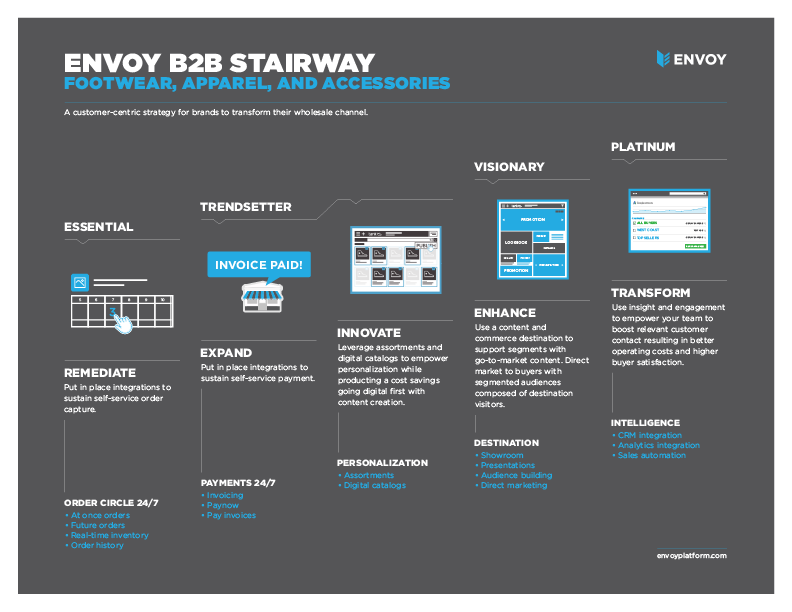The connection that your reps have built with your retailers is an essential piece of your brand’s success. Being able to build real relationships with your buyers and deliver a human touch to your wholesale channel is a must in our industry. It’s a key element of running a modern, hybrid strategy across your wholesale channel.
The other half of that hybrid approach is supporting those human connections with smart digital tools. Are you offering your users a single destination that encourages collaboration during the seasonal journey? Does that destination have easily accessible content and commerce tools that help stores grow and brands expand? If not, it might be time to consider stepping your organization up to a B2B e-commerce platform that supports the hybrid approach that the current climate demands.
But, we know that putting a new platform in place can be daunting as it has the potential to be disruptive to that ability to connect with retailers. Fortunately, there’s a clear way to make the process approachable, while at the same time keeping your reps connected.
We call it the Envoy B2B stairway.

Whether you’re a growing brand looking to start building out your wholesale channel, or an international brand looking to transition into a better platform, the upgrade process is best approached as if it were a stairway. This is a common approach to software implementation that, when adapted to B2B e-commerce, offers a simple way to think about putting your platform in place and adopting a modern strategy to be more successful with your wholesale channels.
This staircase approach allows your team to take measured, impactful steps into the new software in a way that lets them maintain those critical human connections and foster growth.
Your organization may currently be in several different stages of the adoption process simultaneously. This doesn’t mean you need to start over in order to implement this staircase approach. Simply adopt these best practices going forward into future stages. Once you have your team aligned on these goals, you’ll find that your adoption of staircase best practices becomes smooth and simple.
Linear Feature Expansion
Adoption of any new platform within your organization should be thought about in a series of stages. Each stage should build on the last stage’s capabilities.
It’s best to start your implementation by focusing on order capture. This is the most fundamental purpose of a B2B e-commerce platform and is the basis for all other stages.
Starting here lets your reps and retailers continue to interact on the most critical component of their relationships – building success for the stores and growth for your brand.
Your solution should satisfy all your order types - from replenishment to future orders - right from the start. Subsequent stages will build on these order capabilities and provide a singular destination to support all your buyers’ needs.
Once ordering is in place, your team can move forward through the rest of the implementation, step-by-step, from invoicing to assortments to an educational destination, and so on. This linear, organized expansion let’s your users stay focused and effective in the field as their capabilities logically expand when you bring new features online and your implementation won’t get bogged down.
Focused Validation
Likely you’ve been a part of an implementation where the team is stretched to validate too many interconnected features that all depend on each other. The failure of one leads to the failure of the next until the project is in trouble.
This is often described as the “Big Bang Approach,” where a brand tries to simultaneously implement and release several major elements of a B2B e-commerce platform all at once. This also means working across many different departments within your company at the same time. This only increases the difficulty of achieving success.
While the need to accomplish multiple tasks within an implementation at once can not be entirely avoided, utilizing the staircase approach will encourage putting more focus on specific features within each stage, and to work more closely with each supporting department to validate those features.
Building Knowledge
It’s important for your team and your buyers to be introduced to your new platform in stages as well.
In continuing with the example of starting with an implementation stage focused on order capture, it makes sense to focus your team on this same goal and get them educated and confident with the order capture process. This will be leveraged in the rest of the platform as you roll it out.
For example, when it comes time to implement marketing features, your marketing team will already have experience with your order capture system. They will understand, through training and direct experience, how your B2B processes and business rules operate. This will enable the marketing team to leverage product segmentation as they embrace building out a modern commercial marketing plan within your B2B e-commerce platform.
A Clear Adoption
The outcome of linear feature expansion, focused validation, and building knowledge within your user base will be a clear adoption plan. You will have a clear set of associated features and workflows that need to be adopted.
Building knowledge within your organization is the key to a successful adoption, but how do you get the team on board without overwhelming them? It’s simply too hard and ineffective to try and educate and get your entire user base excited about too much too quickly. Timing is critical, but rolling out too much in the middle of the season is a recipe for disaster.
The solution is to build that internal knowledge in stages. Establish a base of readily available, knowledgeable experts that can educate and excite the rest of your internal users.
Get Started
Where are you on the stairway and what are your challenges? With these best practices we have successfully helped brands adopt the Envoy B2B e-commerce platform alongside a modern, hybrid wholesale strategy to elevate the success of their brand. Reach out, let’s grow!
